UTS: Quality Planning & Analysis - Power Transformer Design Report
VerifiedAdded on 2023/06/11
|34
|7042
|312
Report
AI Summary
This report provides a comprehensive analysis of quality planning and analysis in the context of power transformer design and maintenance by ABC Pvt. Ltd. The report begins with an executive summary and introduction, highlighting the significance of power transformers in the energy supply chain. It delves into customer satisfaction, stakeholder analysis, and methods for capturing customer needs such as surveys, focus groups, complaints, customer visits, and interviews. The report employs KANO analysis to categorize customer requirements and translates these needs into design requirements using Quality Function Deployment (QFD). Design risk analysis is conducted using Failure Mode and Effects Analysis (FMEA). The report further discusses supplier evaluation and selection, outlining the identification of components, criteria for the supply chain, and the construction of a supplier choice model. Statistical process control (SPC) is addressed, including the identification of procedures and the use of SPC charts for monitoring. Finally, the report explores problem-solving tools such as brainstorming, why-why analysis, cause-and-effect diagrams, and Pareto analysis. The study references ISO 9001:2015 for quality guidelines.

UTS: ENGINEERING
Assignment Cover Sheet
STANDARD Mode
SUBJECT: Quality Planning and Analysis
SUBJECT NUMBER:
ASSIGNMENT NUMBER:
STUDENT LAST NAME:
STUDENT FIRST NAME:
STUDENT ID:
Assignment Cover Sheet
STANDARD Mode
SUBJECT: Quality Planning and Analysis
SUBJECT NUMBER:
ASSIGNMENT NUMBER:
STUDENT LAST NAME:
STUDENT FIRST NAME:
STUDENT ID:
Paraphrase This Document
Need a fresh take? Get an instant paraphrase of this document with our AI Paraphraser
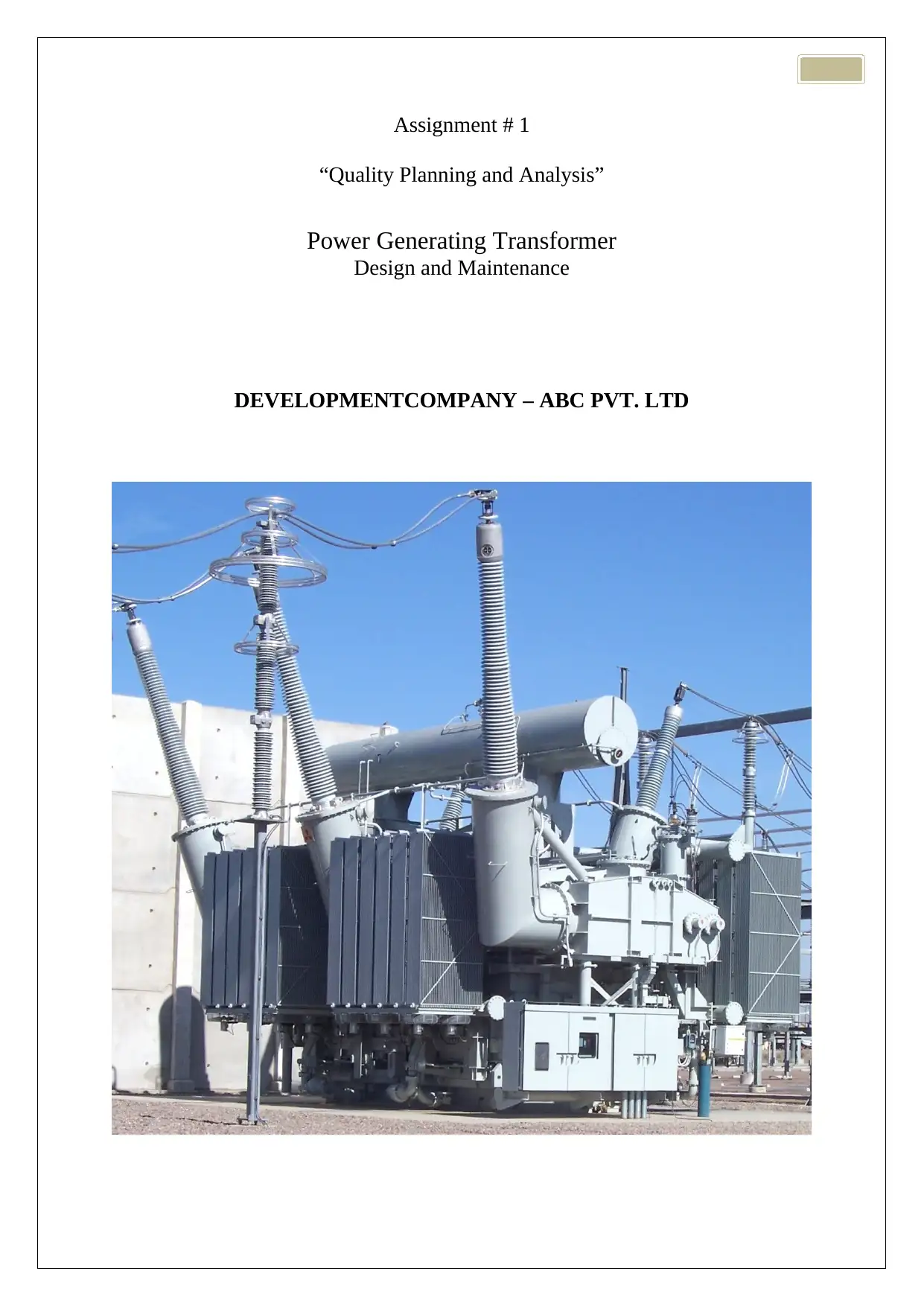
Assignment # 1
“Quality Planning and Analysis”
Power Generating Transformer
Design and Maintenance
DEVELOPMENTCOMPANY – ABC PVT. LTD
“Quality Planning and Analysis”
Power Generating Transformer
Design and Maintenance
DEVELOPMENTCOMPANY – ABC PVT. LTD
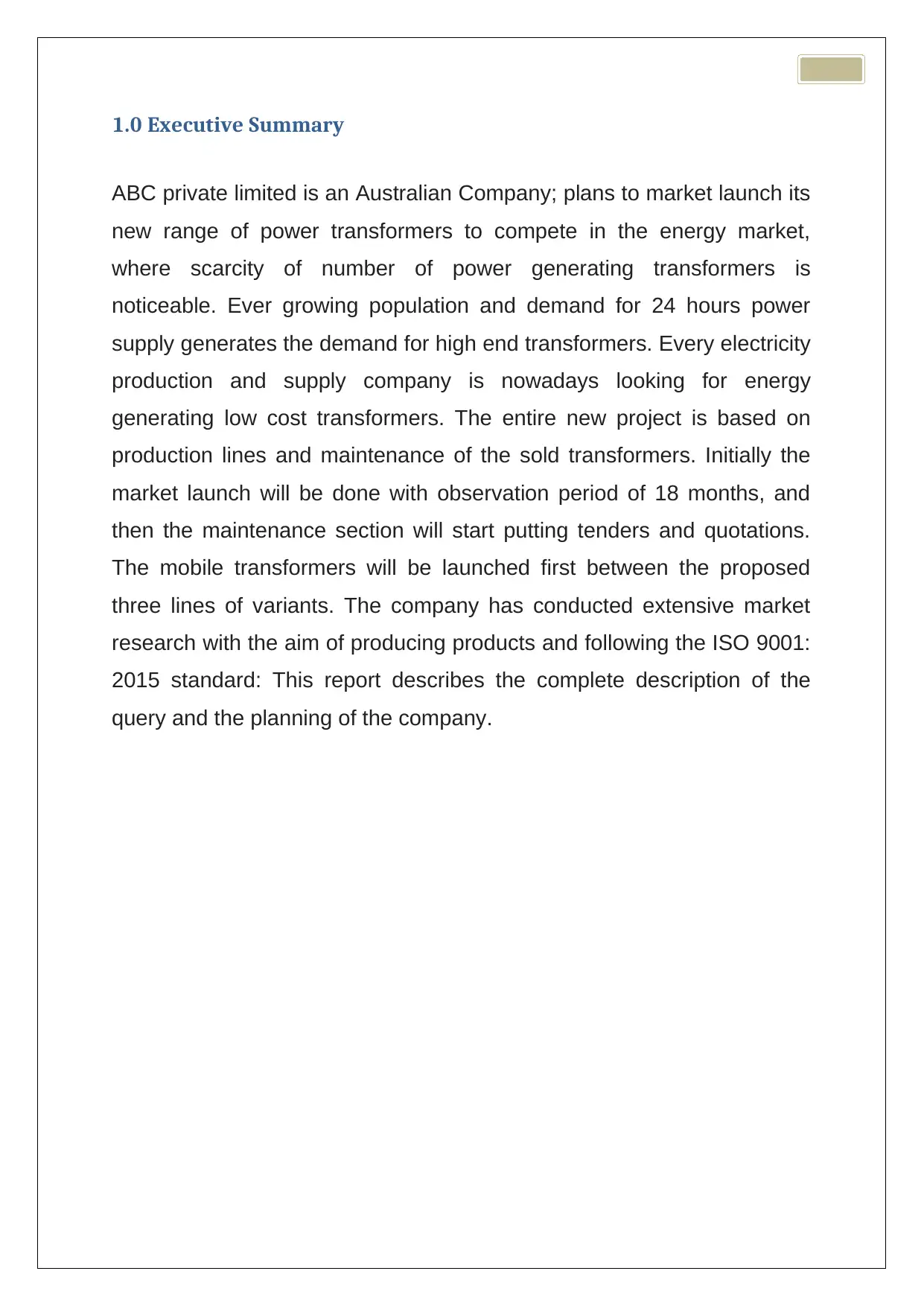
1.0 Executive Summary
ABC private limited is an Australian Company; plans to market launch its
new range of power transformers to compete in the energy market,
where scarcity of number of power generating transformers is
noticeable. Ever growing population and demand for 24 hours power
supply generates the demand for high end transformers. Every electricity
production and supply company is nowadays looking for energy
generating low cost transformers. The entire new project is based on
production lines and maintenance of the sold transformers. Initially the
market launch will be done with observation period of 18 months, and
then the maintenance section will start putting tenders and quotations.
The mobile transformers will be launched first between the proposed
three lines of variants. The company has conducted extensive market
research with the aim of producing products and following the ISO 9001:
2015 standard: This report describes the complete description of the
query and the planning of the company.
ABC private limited is an Australian Company; plans to market launch its
new range of power transformers to compete in the energy market,
where scarcity of number of power generating transformers is
noticeable. Ever growing population and demand for 24 hours power
supply generates the demand for high end transformers. Every electricity
production and supply company is nowadays looking for energy
generating low cost transformers. The entire new project is based on
production lines and maintenance of the sold transformers. Initially the
market launch will be done with observation period of 18 months, and
then the maintenance section will start putting tenders and quotations.
The mobile transformers will be launched first between the proposed
three lines of variants. The company has conducted extensive market
research with the aim of producing products and following the ISO 9001:
2015 standard: This report describes the complete description of the
query and the planning of the company.
⊘ This is a preview!⊘
Do you want full access?
Subscribe today to unlock all pages.

Trusted by 1+ million students worldwide
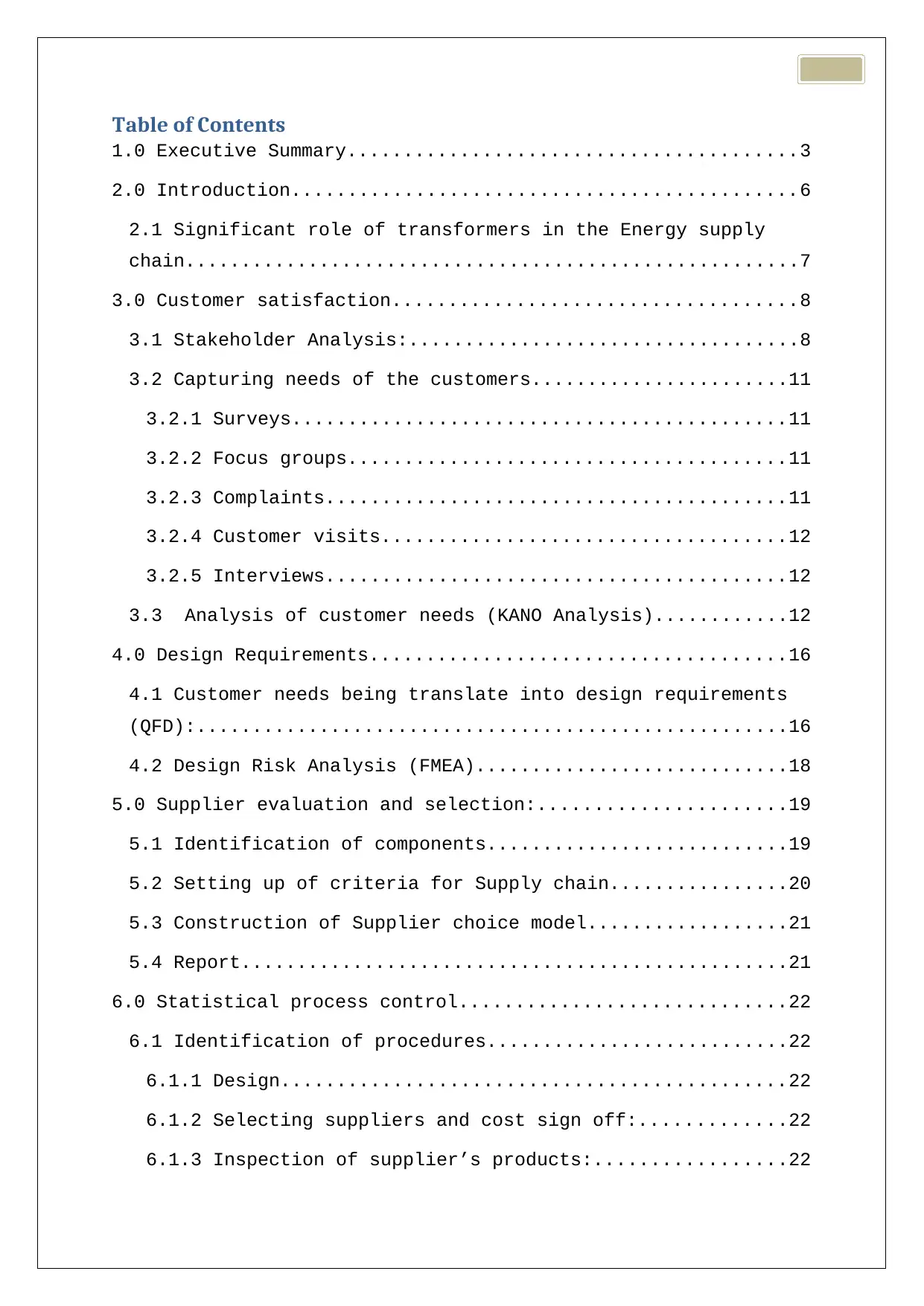
Table of Contents
1.0 Executive Summary........................................3
2.0 Introduction.............................................6
2.1 Significant role of transformers in the Energy supply
chain.......................................................7
3.0 Customer satisfaction....................................8
3.1 Stakeholder Analysis:...................................8
3.2 Capturing needs of the customers.......................11
3.2.1 Surveys............................................11
3.2.2 Focus groups.......................................11
3.2.3 Complaints.........................................11
3.2.4 Customer visits....................................12
3.2.5 Interviews.........................................12
3.3 Analysis of customer needs (KANO Analysis)............12
4.0 Design Requirements.....................................16
4.1 Customer needs being translate into design requirements
(QFD):.....................................................16
4.2 Design Risk Analysis (FMEA)............................18
5.0 Supplier evaluation and selection:......................19
5.1 Identification of components...........................19
5.2 Setting up of criteria for Supply chain................20
5.3 Construction of Supplier choice model..................21
5.4 Report.................................................21
6.0 Statistical process control.............................22
6.1 Identification of procedures...........................22
6.1.1 Design.............................................22
6.1.2 Selecting suppliers and cost sign off:.............22
6.1.3 Inspection of supplier’s products:.................22
1.0 Executive Summary........................................3
2.0 Introduction.............................................6
2.1 Significant role of transformers in the Energy supply
chain.......................................................7
3.0 Customer satisfaction....................................8
3.1 Stakeholder Analysis:...................................8
3.2 Capturing needs of the customers.......................11
3.2.1 Surveys............................................11
3.2.2 Focus groups.......................................11
3.2.3 Complaints.........................................11
3.2.4 Customer visits....................................12
3.2.5 Interviews.........................................12
3.3 Analysis of customer needs (KANO Analysis)............12
4.0 Design Requirements.....................................16
4.1 Customer needs being translate into design requirements
(QFD):.....................................................16
4.2 Design Risk Analysis (FMEA)............................18
5.0 Supplier evaluation and selection:......................19
5.1 Identification of components...........................19
5.2 Setting up of criteria for Supply chain................20
5.3 Construction of Supplier choice model..................21
5.4 Report.................................................21
6.0 Statistical process control.............................22
6.1 Identification of procedures...........................22
6.1.1 Design.............................................22
6.1.2 Selecting suppliers and cost sign off:.............22
6.1.3 Inspection of supplier’s products:.................22
Paraphrase This Document
Need a fresh take? Get an instant paraphrase of this document with our AI Paraphraser
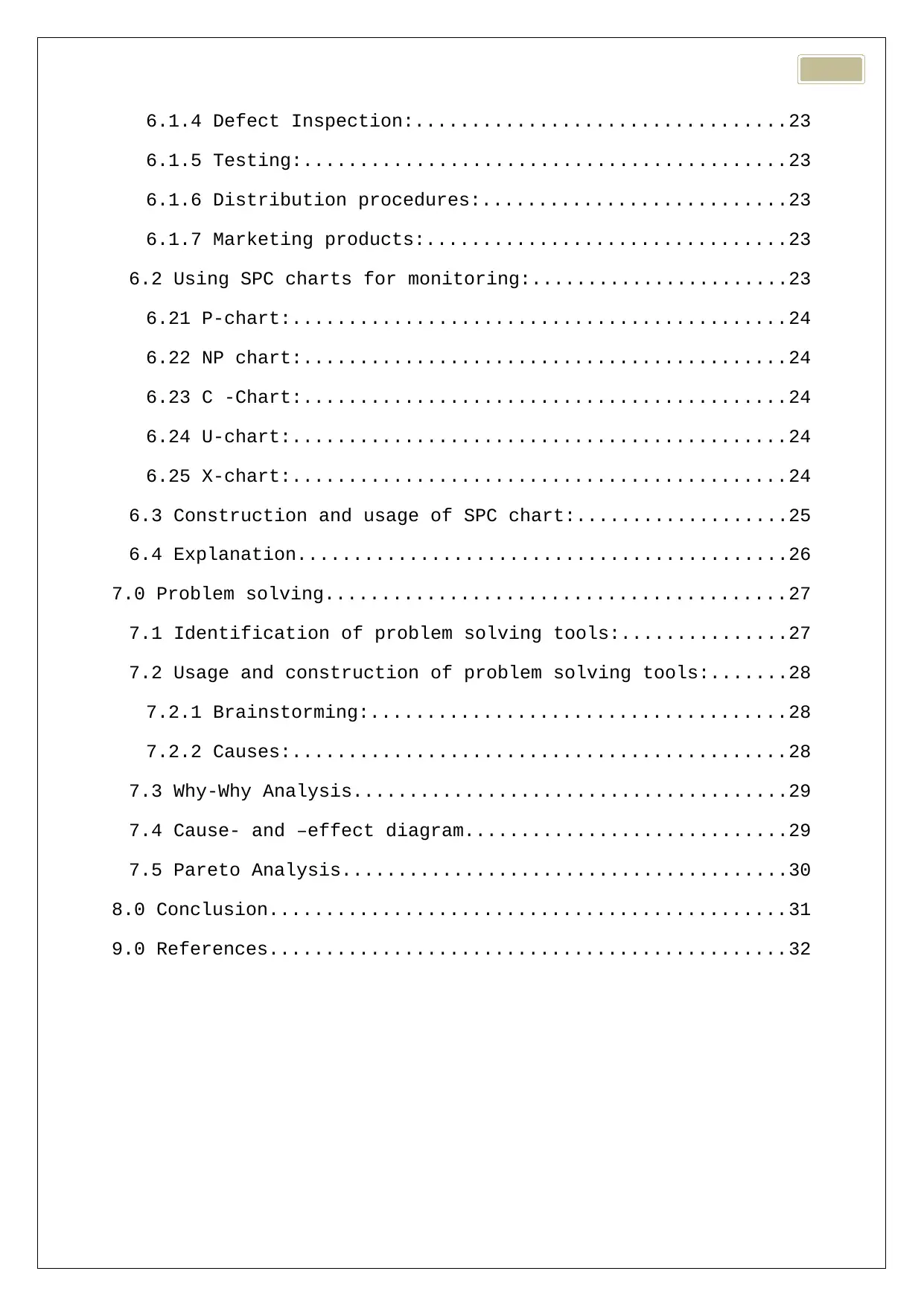
6.1.4 Defect Inspection:.................................23
6.1.5 Testing:...........................................23
6.1.6 Distribution procedures:...........................23
6.1.7 Marketing products:................................23
6.2 Using SPC charts for monitoring:.......................23
6.21 P-chart:............................................24
6.22 NP chart:...........................................24
6.23 C -Chart:...........................................24
6.24 U-chart:............................................24
6.25 X-chart:............................................24
6.3 Construction and usage of SPC chart:...................25
6.4 Explanation............................................26
7.0 Problem solving.........................................27
7.1 Identification of problem solving tools:...............27
7.2 Usage and construction of problem solving tools:.......28
7.2.1 Brainstorming:.....................................28
7.2.2 Causes:............................................28
7.3 Why-Why Analysis.......................................29
7.4 Cause- and –effect diagram.............................29
7.5 Pareto Analysis........................................30
8.0 Conclusion..............................................31
9.0 References..............................................32
6.1.5 Testing:...........................................23
6.1.6 Distribution procedures:...........................23
6.1.7 Marketing products:................................23
6.2 Using SPC charts for monitoring:.......................23
6.21 P-chart:............................................24
6.22 NP chart:...........................................24
6.23 C -Chart:...........................................24
6.24 U-chart:............................................24
6.25 X-chart:............................................24
6.3 Construction and usage of SPC chart:...................25
6.4 Explanation............................................26
7.0 Problem solving.........................................27
7.1 Identification of problem solving tools:...............27
7.2 Usage and construction of problem solving tools:.......28
7.2.1 Brainstorming:.....................................28
7.2.2 Causes:............................................28
7.3 Why-Why Analysis.......................................29
7.4 Cause- and –effect diagram.............................29
7.5 Pareto Analysis........................................30
8.0 Conclusion..............................................31
9.0 References..............................................32
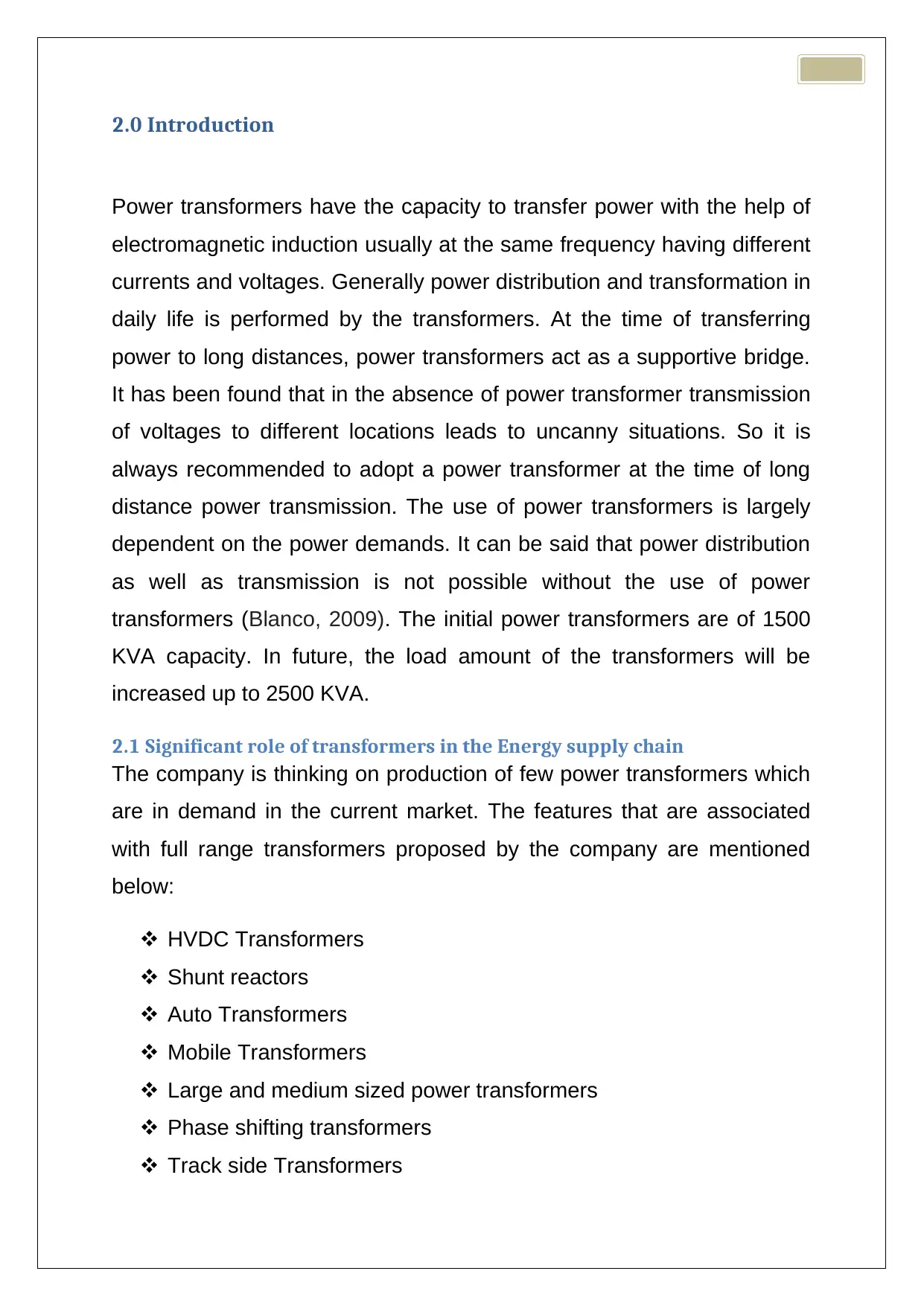
2.0 Introduction
Power transformers have the capacity to transfer power with the help of
electromagnetic induction usually at the same frequency having different
currents and voltages. Generally power distribution and transformation in
daily life is performed by the transformers. At the time of transferring
power to long distances, power transformers act as a supportive bridge.
It has been found that in the absence of power transformer transmission
of voltages to different locations leads to uncanny situations. So it is
always recommended to adopt a power transformer at the time of long
distance power transmission. The use of power transformers is largely
dependent on the power demands. It can be said that power distribution
as well as transmission is not possible without the use of power
transformers (Blanco, 2009). The initial power transformers are of 1500
KVA capacity. In future, the load amount of the transformers will be
increased up to 2500 KVA.
2.1 Significant role of transformers in the Energy supply chain
The company is thinking on production of few power transformers which
are in demand in the current market. The features that are associated
with full range transformers proposed by the company are mentioned
below:
HVDC Transformers
Shunt reactors
Auto Transformers
Mobile Transformers
Large and medium sized power transformers
Phase shifting transformers
Track side Transformers
Power transformers have the capacity to transfer power with the help of
electromagnetic induction usually at the same frequency having different
currents and voltages. Generally power distribution and transformation in
daily life is performed by the transformers. At the time of transferring
power to long distances, power transformers act as a supportive bridge.
It has been found that in the absence of power transformer transmission
of voltages to different locations leads to uncanny situations. So it is
always recommended to adopt a power transformer at the time of long
distance power transmission. The use of power transformers is largely
dependent on the power demands. It can be said that power distribution
as well as transmission is not possible without the use of power
transformers (Blanco, 2009). The initial power transformers are of 1500
KVA capacity. In future, the load amount of the transformers will be
increased up to 2500 KVA.
2.1 Significant role of transformers in the Energy supply chain
The company is thinking on production of few power transformers which
are in demand in the current market. The features that are associated
with full range transformers proposed by the company are mentioned
below:
HVDC Transformers
Shunt reactors
Auto Transformers
Mobile Transformers
Large and medium sized power transformers
Phase shifting transformers
Track side Transformers
⊘ This is a preview!⊘
Do you want full access?
Subscribe today to unlock all pages.

Trusted by 1+ million students worldwide
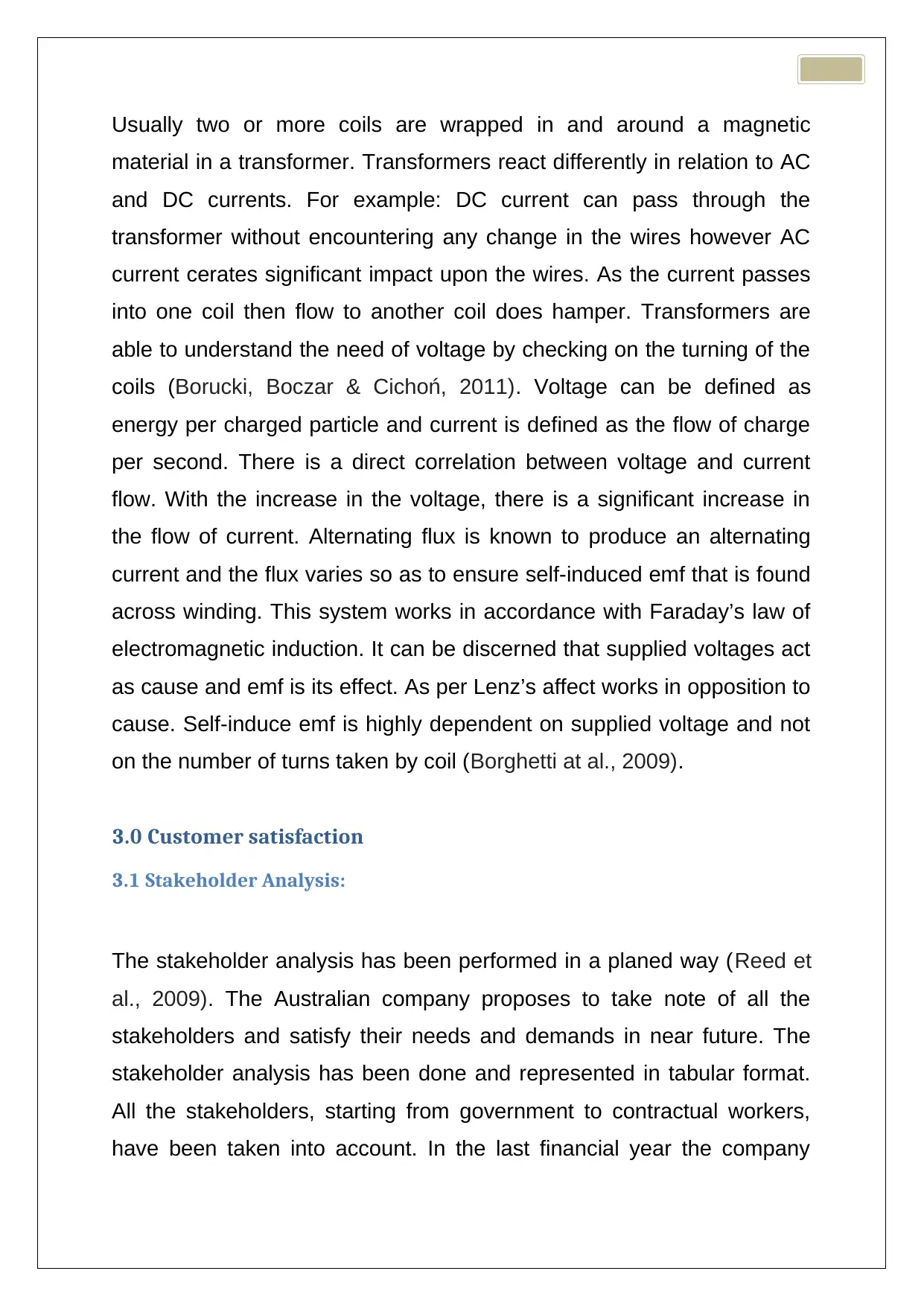
Usually two or more coils are wrapped in and around a magnetic
material in a transformer. Transformers react differently in relation to AC
and DC currents. For example: DC current can pass through the
transformer without encountering any change in the wires however AC
current cerates significant impact upon the wires. As the current passes
into one coil then flow to another coil does hamper. Transformers are
able to understand the need of voltage by checking on the turning of the
coils (Borucki, Boczar & Cichoń, 2011). Voltage can be defined as
energy per charged particle and current is defined as the flow of charge
per second. There is a direct correlation between voltage and current
flow. With the increase in the voltage, there is a significant increase in
the flow of current. Alternating flux is known to produce an alternating
current and the flux varies so as to ensure self-induced emf that is found
across winding. This system works in accordance with Faraday’s law of
electromagnetic induction. It can be discerned that supplied voltages act
as cause and emf is its effect. As per Lenz’s affect works in opposition to
cause. Self-induce emf is highly dependent on supplied voltage and not
on the number of turns taken by coil (Borghetti at al., 2009).
3.0 Customer satisfaction
3.1 Stakeholder Analysis:
The stakeholder analysis has been performed in a planed way (Reed et
al., 2009). The Australian company proposes to take note of all the
stakeholders and satisfy their needs and demands in near future. The
stakeholder analysis has been done and represented in tabular format.
All the stakeholders, starting from government to contractual workers,
have been taken into account. In the last financial year the company
material in a transformer. Transformers react differently in relation to AC
and DC currents. For example: DC current can pass through the
transformer without encountering any change in the wires however AC
current cerates significant impact upon the wires. As the current passes
into one coil then flow to another coil does hamper. Transformers are
able to understand the need of voltage by checking on the turning of the
coils (Borucki, Boczar & Cichoń, 2011). Voltage can be defined as
energy per charged particle and current is defined as the flow of charge
per second. There is a direct correlation between voltage and current
flow. With the increase in the voltage, there is a significant increase in
the flow of current. Alternating flux is known to produce an alternating
current and the flux varies so as to ensure self-induced emf that is found
across winding. This system works in accordance with Faraday’s law of
electromagnetic induction. It can be discerned that supplied voltages act
as cause and emf is its effect. As per Lenz’s affect works in opposition to
cause. Self-induce emf is highly dependent on supplied voltage and not
on the number of turns taken by coil (Borghetti at al., 2009).
3.0 Customer satisfaction
3.1 Stakeholder Analysis:
The stakeholder analysis has been performed in a planed way (Reed et
al., 2009). The Australian company proposes to take note of all the
stakeholders and satisfy their needs and demands in near future. The
stakeholder analysis has been done and represented in tabular format.
All the stakeholders, starting from government to contractual workers,
have been taken into account. In the last financial year the company
Paraphrase This Document
Need a fresh take? Get an instant paraphrase of this document with our AI Paraphraser
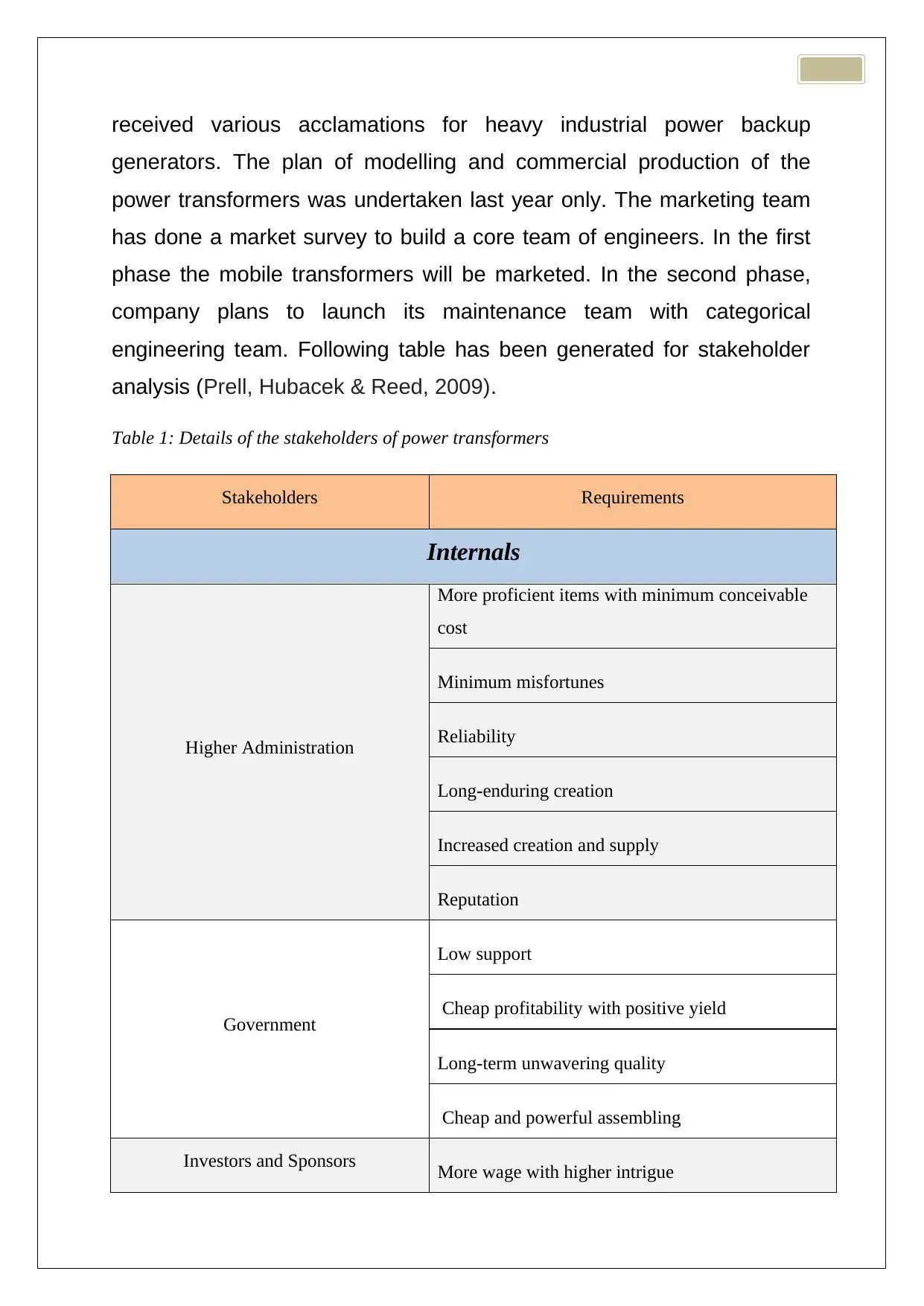
received various acclamations for heavy industrial power backup
generators. The plan of modelling and commercial production of the
power transformers was undertaken last year only. The marketing team
has done a market survey to build a core team of engineers. In the first
phase the mobile transformers will be marketed. In the second phase,
company plans to launch its maintenance team with categorical
engineering team. Following table has been generated for stakeholder
analysis (Prell, Hubacek & Reed, 2009).
Table 1: Details of the stakeholders of power transformers
Stakeholders Requirements
Internals
Higher Administration
More proficient items with minimum conceivable
cost
Minimum misfortunes
Reliability
Long-enduring creation
Increased creation and supply
Reputation
Government
Low support
Cheap profitability with positive yield
Long-term unwavering quality
Cheap and powerful assembling
Investors and Sponsors More wage with higher intrigue
generators. The plan of modelling and commercial production of the
power transformers was undertaken last year only. The marketing team
has done a market survey to build a core team of engineers. In the first
phase the mobile transformers will be marketed. In the second phase,
company plans to launch its maintenance team with categorical
engineering team. Following table has been generated for stakeholder
analysis (Prell, Hubacek & Reed, 2009).
Table 1: Details of the stakeholders of power transformers
Stakeholders Requirements
Internals
Higher Administration
More proficient items with minimum conceivable
cost
Minimum misfortunes
Reliability
Long-enduring creation
Increased creation and supply
Reputation
Government
Low support
Cheap profitability with positive yield
Long-term unwavering quality
Cheap and powerful assembling
Investors and Sponsors More wage with higher intrigue
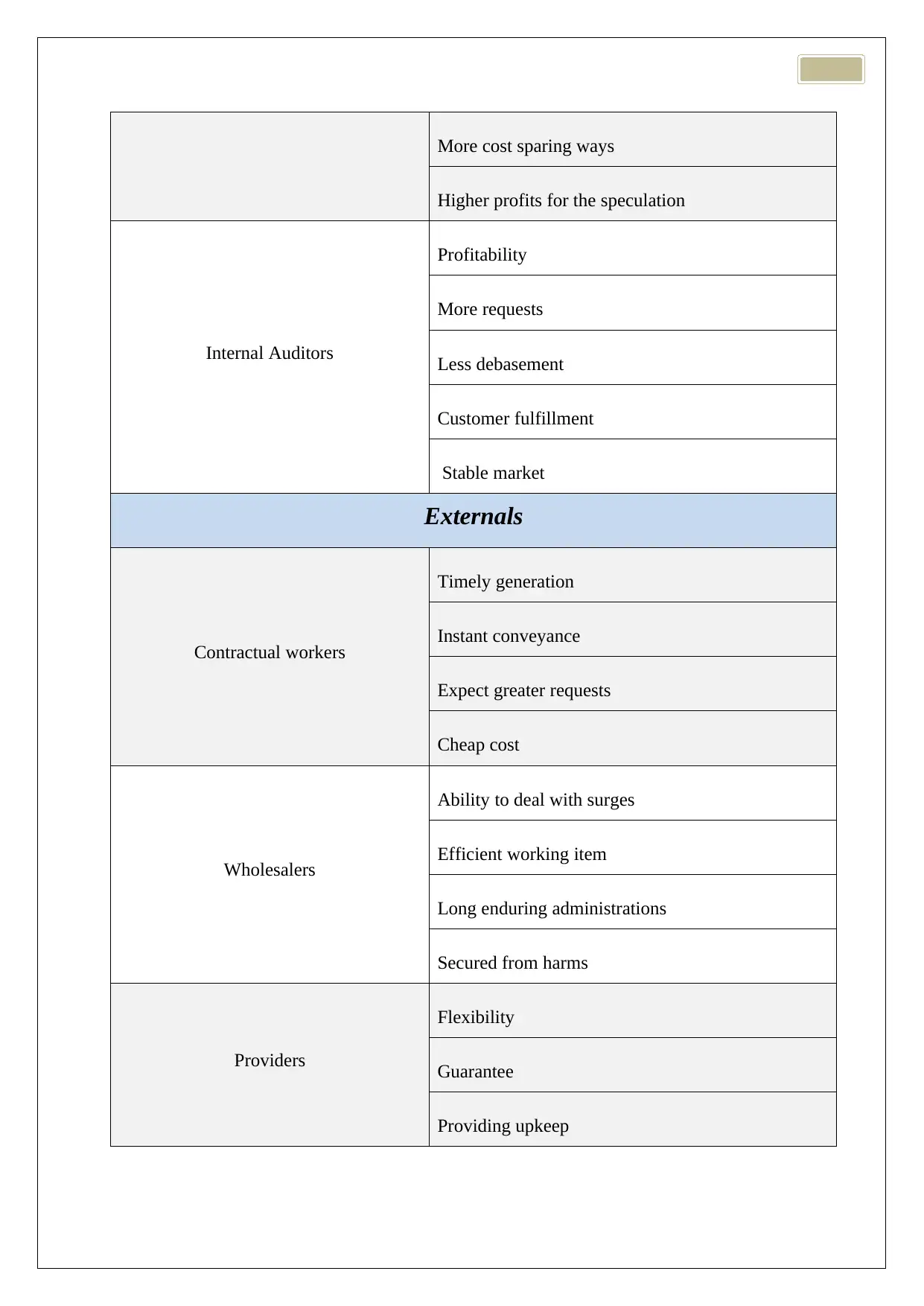
More cost sparing ways
Higher profits for the speculation
Internal Auditors
Profitability
More requests
Less debasement
Customer fulfillment
Stable market
Externals
Contractual workers
Timely generation
Instant conveyance
Expect greater requests
Cheap cost
Wholesalers
Ability to deal with surges
Efficient working item
Long enduring administrations
Secured from harms
Providers
Flexibility
Guarantee
Providing upkeep
Higher profits for the speculation
Internal Auditors
Profitability
More requests
Less debasement
Customer fulfillment
Stable market
Externals
Contractual workers
Timely generation
Instant conveyance
Expect greater requests
Cheap cost
Wholesalers
Ability to deal with surges
Efficient working item
Long enduring administrations
Secured from harms
Providers
Flexibility
Guarantee
Providing upkeep
⊘ This is a preview!⊘
Do you want full access?
Subscribe today to unlock all pages.

Trusted by 1+ million students worldwide
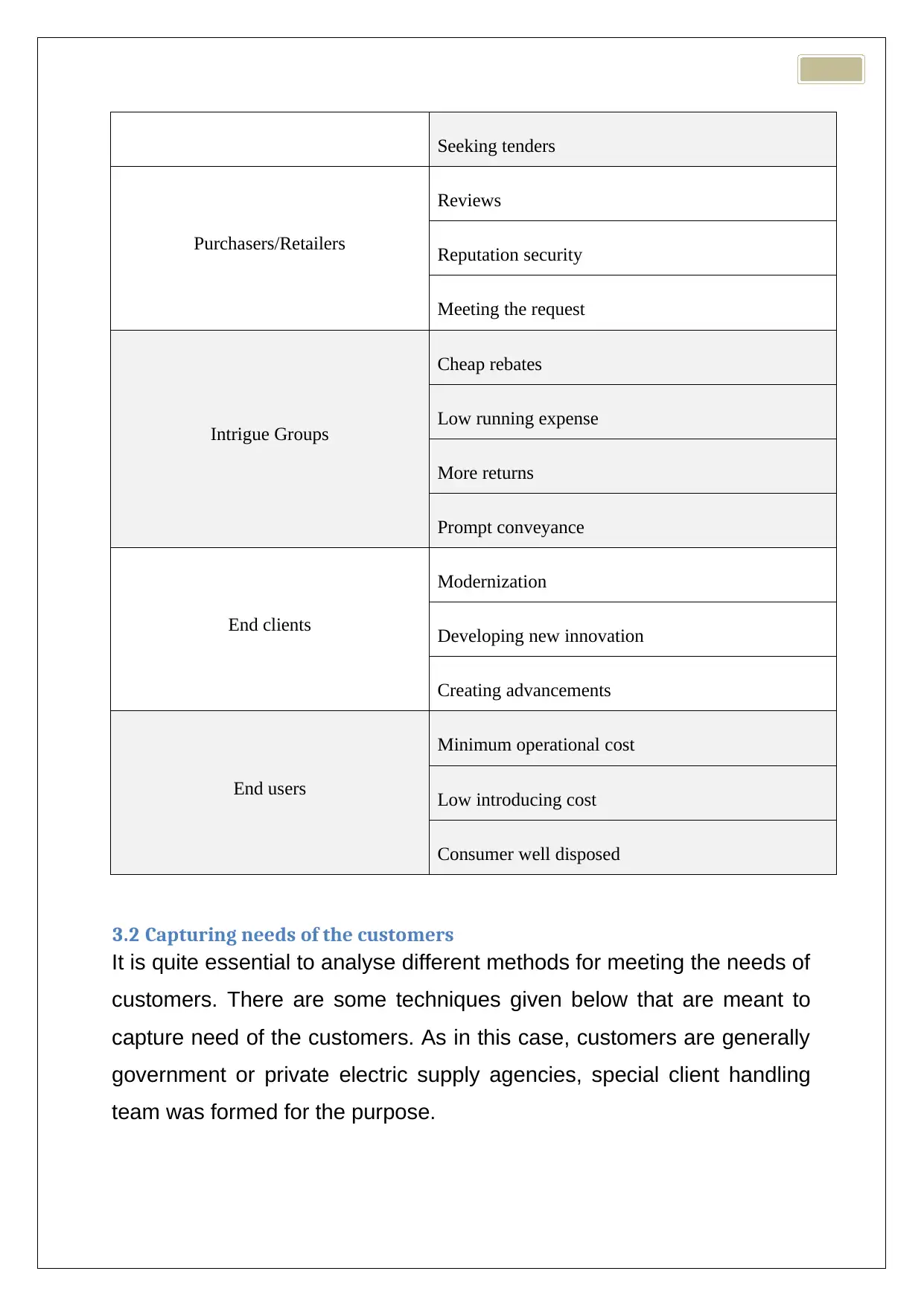
Seeking tenders
Purchasers/Retailers
Reviews
Reputation security
Meeting the request
Intrigue Groups
Cheap rebates
Low running expense
More returns
Prompt conveyance
End clients
Modernization
Developing new innovation
Creating advancements
End users
Minimum operational cost
Low introducing cost
Consumer well disposed
3.2 Capturing needs of the customers
It is quite essential to analyse different methods for meeting the needs of
customers. There are some techniques given below that are meant to
capture need of the customers. As in this case, customers are generally
government or private electric supply agencies, special client handling
team was formed for the purpose.
Purchasers/Retailers
Reviews
Reputation security
Meeting the request
Intrigue Groups
Cheap rebates
Low running expense
More returns
Prompt conveyance
End clients
Modernization
Developing new innovation
Creating advancements
End users
Minimum operational cost
Low introducing cost
Consumer well disposed
3.2 Capturing needs of the customers
It is quite essential to analyse different methods for meeting the needs of
customers. There are some techniques given below that are meant to
capture need of the customers. As in this case, customers are generally
government or private electric supply agencies, special client handling
team was formed for the purpose.
Paraphrase This Document
Need a fresh take? Get an instant paraphrase of this document with our AI Paraphraser
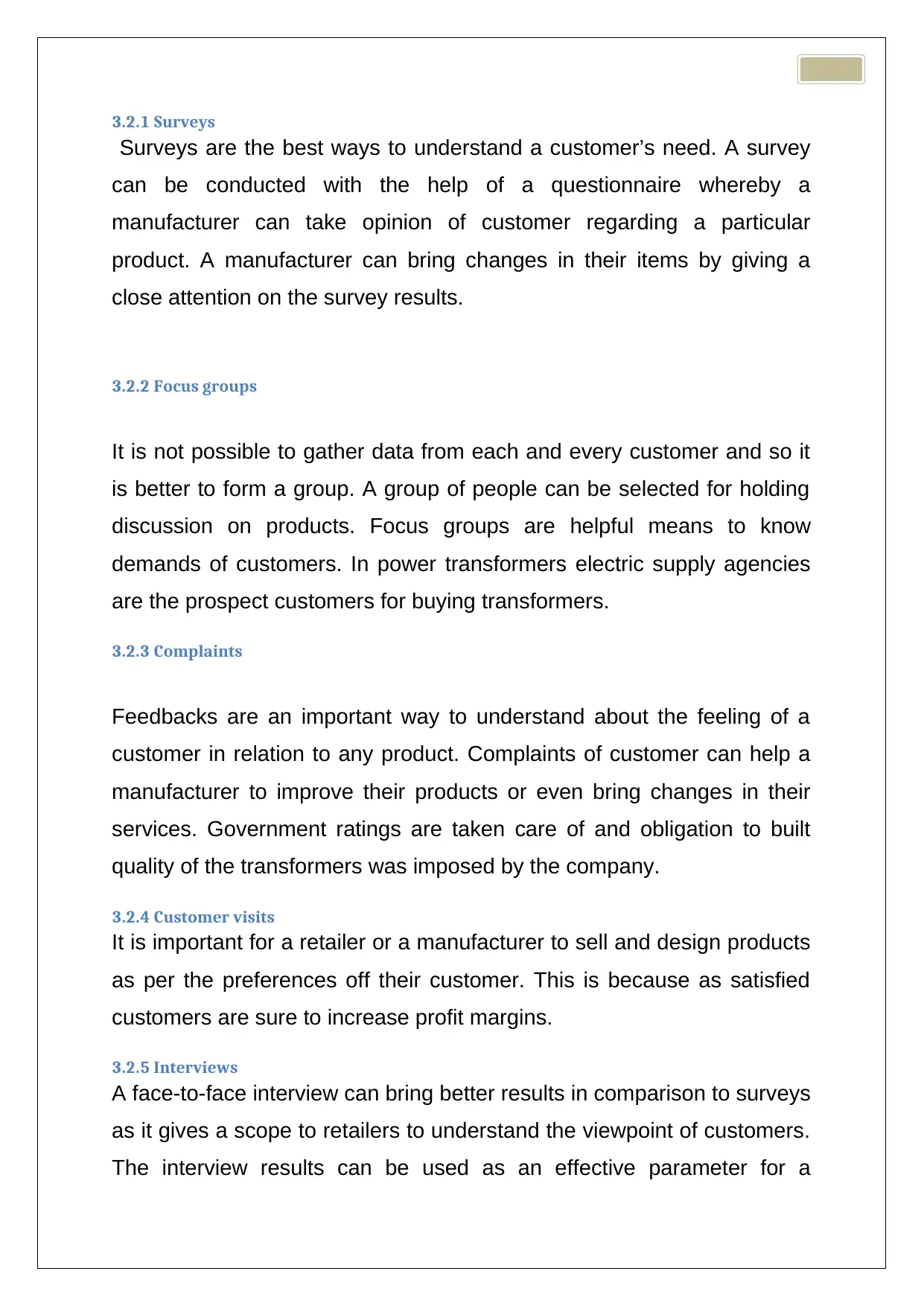
3.2.1 Surveys
Surveys are the best ways to understand a customer’s need. A survey
can be conducted with the help of a questionnaire whereby a
manufacturer can take opinion of customer regarding a particular
product. A manufacturer can bring changes in their items by giving a
close attention on the survey results.
3.2.2 Focus groups
It is not possible to gather data from each and every customer and so it
is better to form a group. A group of people can be selected for holding
discussion on products. Focus groups are helpful means to know
demands of customers. In power transformers electric supply agencies
are the prospect customers for buying transformers.
3.2.3 Complaints
Feedbacks are an important way to understand about the feeling of a
customer in relation to any product. Complaints of customer can help a
manufacturer to improve their products or even bring changes in their
services. Government ratings are taken care of and obligation to built
quality of the transformers was imposed by the company.
3.2.4 Customer visits
It is important for a retailer or a manufacturer to sell and design products
as per the preferences off their customer. This is because as satisfied
customers are sure to increase profit margins.
3.2.5 Interviews
A face-to-face interview can bring better results in comparison to surveys
as it gives a scope to retailers to understand the viewpoint of customers.
The interview results can be used as an effective parameter for a
Surveys are the best ways to understand a customer’s need. A survey
can be conducted with the help of a questionnaire whereby a
manufacturer can take opinion of customer regarding a particular
product. A manufacturer can bring changes in their items by giving a
close attention on the survey results.
3.2.2 Focus groups
It is not possible to gather data from each and every customer and so it
is better to form a group. A group of people can be selected for holding
discussion on products. Focus groups are helpful means to know
demands of customers. In power transformers electric supply agencies
are the prospect customers for buying transformers.
3.2.3 Complaints
Feedbacks are an important way to understand about the feeling of a
customer in relation to any product. Complaints of customer can help a
manufacturer to improve their products or even bring changes in their
services. Government ratings are taken care of and obligation to built
quality of the transformers was imposed by the company.
3.2.4 Customer visits
It is important for a retailer or a manufacturer to sell and design products
as per the preferences off their customer. This is because as satisfied
customers are sure to increase profit margins.
3.2.5 Interviews
A face-to-face interview can bring better results in comparison to surveys
as it gives a scope to retailers to understand the viewpoint of customers.
The interview results can be used as an effective parameter for a
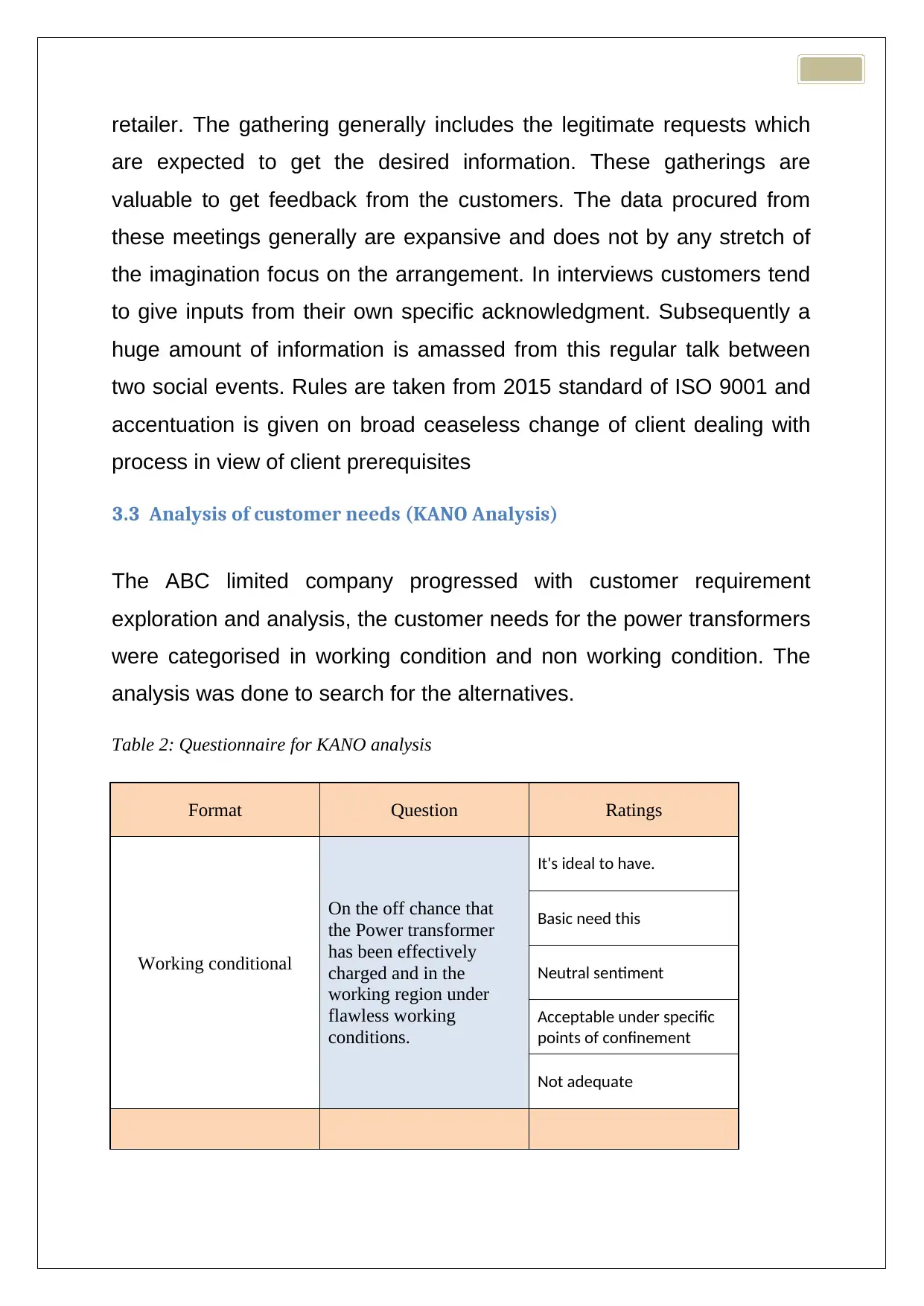
retailer. The gathering generally includes the legitimate requests which
are expected to get the desired information. These gatherings are
valuable to get feedback from the customers. The data procured from
these meetings generally are expansive and does not by any stretch of
the imagination focus on the arrangement. In interviews customers tend
to give inputs from their own specific acknowledgment. Subsequently a
huge amount of information is amassed from this regular talk between
two social events. Rules are taken from 2015 standard of ISO 9001 and
accentuation is given on broad ceaseless change of client dealing with
process in view of client prerequisites
3.3 Analysis of customer needs (KANO Analysis)
The ABC limited company progressed with customer requirement
exploration and analysis, the customer needs for the power transformers
were categorised in working condition and non working condition. The
analysis was done to search for the alternatives.
Table 2: Questionnaire for KANO analysis
Format Question Ratings
Working conditional
On the off chance that
the Power transformer
has been effectively
charged and in the
working region under
flawless working
conditions.
It's ideal to have.
Basic need this
Neutral sentiment
Acceptable under specific
points of confinement
Not adequate
are expected to get the desired information. These gatherings are
valuable to get feedback from the customers. The data procured from
these meetings generally are expansive and does not by any stretch of
the imagination focus on the arrangement. In interviews customers tend
to give inputs from their own specific acknowledgment. Subsequently a
huge amount of information is amassed from this regular talk between
two social events. Rules are taken from 2015 standard of ISO 9001 and
accentuation is given on broad ceaseless change of client dealing with
process in view of client prerequisites
3.3 Analysis of customer needs (KANO Analysis)
The ABC limited company progressed with customer requirement
exploration and analysis, the customer needs for the power transformers
were categorised in working condition and non working condition. The
analysis was done to search for the alternatives.
Table 2: Questionnaire for KANO analysis
Format Question Ratings
Working conditional
On the off chance that
the Power transformer
has been effectively
charged and in the
working region under
flawless working
conditions.
It's ideal to have.
Basic need this
Neutral sentiment
Acceptable under specific
points of confinement
Not adequate
⊘ This is a preview!⊘
Do you want full access?
Subscribe today to unlock all pages.

Trusted by 1+ million students worldwide
1 out of 34
Related Documents
Your All-in-One AI-Powered Toolkit for Academic Success.
+13062052269
info@desklib.com
Available 24*7 on WhatsApp / Email
![[object Object]](/_next/static/media/star-bottom.7253800d.svg)
Unlock your academic potential
Copyright © 2020–2025 A2Z Services. All Rights Reserved. Developed and managed by ZUCOL.





